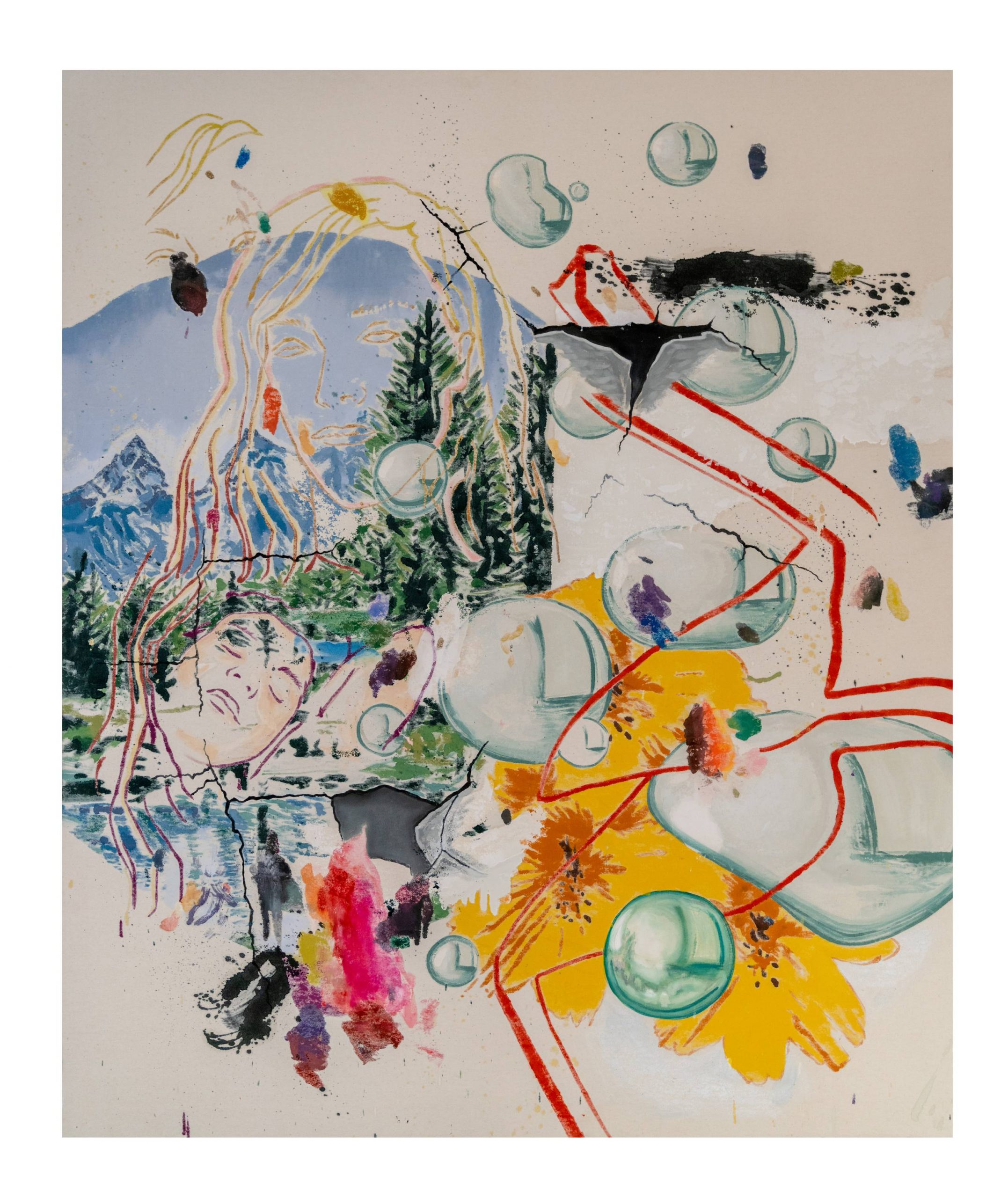Chris Hood, a native of Atlanta, Georgia, was born in 1984. Currently working in a large studio in Manhattan’s trendy East Harlem neighborhood, Hood is an artist, fully and unapologetically a product of his era.
The artist received a degree from the Santa Reparata International School of Art in Florence, Italy in 2003, a Degree from the Welch School of Art in Atlanta, Georgia in 2008, and a master’s degree in Studio Art, from the San Francisco Art Institute, in San Francisco, California in 2010.
Known primarily for fun 21st century “Pop” works – replete with applied emojis, graphic comics, and other clippings – Hood also paints his works in a sweepings colorful gestural style.
Yet it is a unique technique he discovered that truly sets him apart. When Hood begins a work, initially he paints the reverse of his canvases first; allowing the pigments of the “wet oil” he prefers to “bleed through” – creating a “tabula rasa” upon which he then begins.
After he turns the canvases around, first he paints them in a gestural, loose Expressionist style, and finally he peppers them with clippings, cuttings, comics, and any other graphics that strike his fancy. One feels they are watching a new 21the Century “Pop Art” style coming to fruition.
He even loves applying emojis, mixing them with cartoons of, as he says, laughing: ““You know stuff like these zombie monster things – and little characters with angry eyes and smoking hearts.”
His choice of emojis, once explained, does make sense; As he fully understands, in an age in which acronyms and reductive language, have begun to take over social discourse, emojis, photos and short “text” and captions” have become the communicative currency of our time.
They harken back to many other periods in civilization, when illiteracy, among other reasons, made pictures rather than words the only effective means for human communication. “They were everywhere,” Hood laughs, “ And I began to think that how, as dumb as they are, emojis are also beautiful pictorgrams. They reflect the way people have been using images to transmit ideas for millennia. They’re perfect little icons with a big ability to communicate.”
Hood is additionally not an artist afraid to appropriate images and references from works of art that for a variety of reasons have come to occupy such a central role as objects for elite contemplation that other artists might be afraid to access them. Not Hood. For example, has recently even appropriated Van Gogh’s Starry Night for a series of works.
He explains “The Starry Night” motif is a funny story. It came out of a day when I saw that painting repeatedly. There’s this kind of ubiquity to it, and a romance that people attribute to it. It became an interesting motif to me, connecting the public though and an icon of art.
I’m using it in this body of work as a way into the emotional content of the paintings – there’s an inherent, built-up charge that’s associated with Starry Night. It can be read as melancholy, or a notion of sincerity and sentiment, which has always been a “no-no” in art.
I’ve also read that some people consider Starry Night to be one of the first abstract paintings. From Van Goghs vantage point, he couldn’t have geographically placed certain things in the way we see it, and it is one of the first examples in which an artist distorted the picture plane and collapsed the environment to form the image he wanted on.”
In Hood’s work, Van Gogh’s motif of spiraling skies, when painted on the back of one of Hood’s signature “reverse canvases,” the effect is that an even more heightened level of psychedelic distortion and psychic dislocation is brought to the fore.
“The works are a mix of highbrow and lowbrow, control and chaos, tradition, and innovation, and I’m not ashamed, “say the artist. “I think they are aesthetically compelling and conceptually considered.”
And one must agree. The sense is that Hood is tuned into the “the pulse” of his co-millenials, and that ability to tap into the Zeitgeist of hip, young collectors, has led him to star turns in solo and group exhibitions at leading galleries including: Lyles & King in New York, Rod Barton in London, Galerie Bernard Ceysson in Luxembourg, and The Museum of Contemporary Art in Atlanta, Georgia.
Not surprisingly, Hood’s mood regarding his work is also relaxed. “Yes, planning gets me to a certain point, but then a lot of the real fun – getting loose with paint – really takes the paintings to the next level, “ says the artist, grinning in his omnipresent Atlanta Braves baseball cap. “A lot of the choices I make are intended to mix up the information that I’ve already put down on the canvas. Other painters might do the opposite and try to clarify with details, I work the other way – it tends to get more abstract as I paint, as opposed to crystallizing into something.”
Visit The Foundation
If you are interested in visiting the RAK foundation and its collection, we would be happy to show you around. Contact us for more information.
